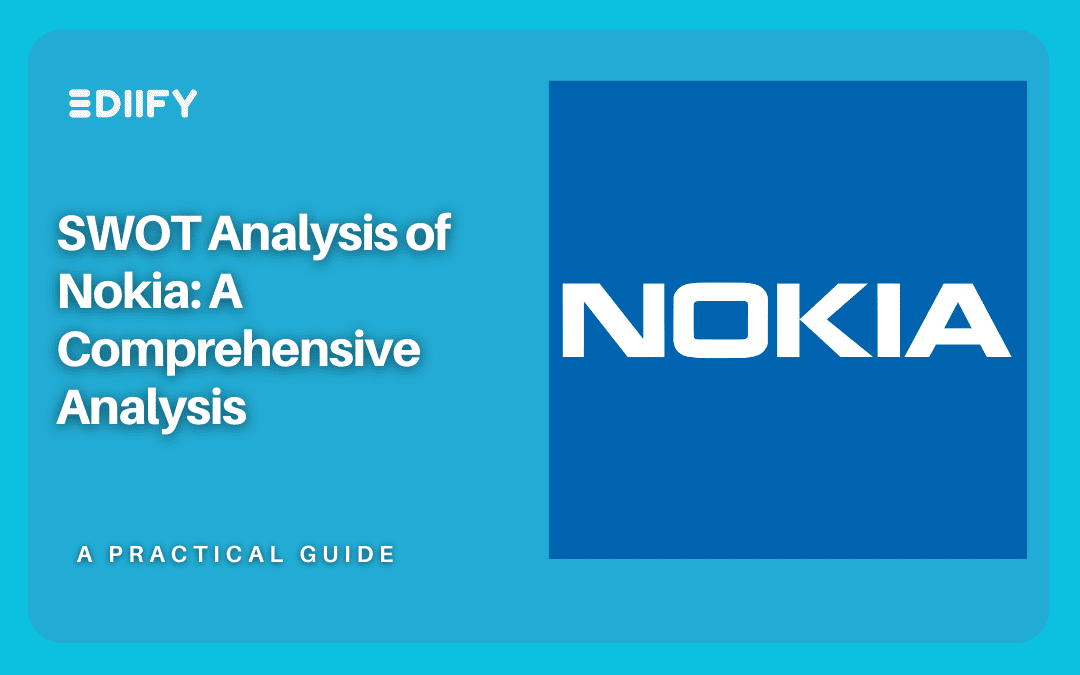Introduction:
In the fast-paced realm of technology, few companies have experienced the tumultuous journey witnessed by Nokia. Once an undisputed leader in the mobile phone industry, Nokia faced significant challenges in adapting to the smartphone era. Its narrative of resilience and adaptation in the face of adversity is both compelling and instructive. To understand Nokia’s current position and future prospects, a thorough SWOT (Strengths, Weaknesses, Opportunities, Threats) analysis of the Nokia industry is essential.

Strengths:
- Brand Legacy: Nokia enjoys a rich heritage and global brand recognition for reliability and durability in mobile devices, offering a substantial advantage.
- Diverse Portfolio: Beyond smartphones, Nokia’s diversified portfolio includes telecommunications infrastructure, network solutions, and digital health products, providing resilience against market fluctuations.
- Research and Development: Nokia’s significant investment in R&D fuels innovation in emerging technologies like 5G, IoT (Internet of Things), and AI (Artificial Intelligence), enhancing its competitiveness.
- Strategic Partnerships: Collaborations with industry giants like Microsoft and Google bolster Nokia’s position in software development and ecosystem integration.
Take a look at the below blog swot analysis of Jio a comprehensive analysis
https://ediify.com/swot-analysis-of-jio-a-comprehensive-analysis/
Weaknesses:
- Late Entry into Smartphone Market: Nokia’s delayed entry into the smartphone market resulted in a loss of market share and brand relevance, allowing competitors to establish dominance.
- Limited Market Presence: Nokia struggles to regain market share in key markets like the United States due to intense competition and a lack of carrier partnerships.
- Dependency on External Platforms: Relying on external platforms like Android for smartphones limits Nokia’s control over software updates and customization, affecting user experience.
- Brand Perception Challenges: Despite efforts to revitalize its brand, Nokia still faces perceptions of being outdated or inferior compared to competitors.
Opportunities:
- 5G Adoption: Nokia’s expertise in telecommunications infrastructure positions it to capitalize on the growing demand for high-speed connectivity with the transition to 5G networks.
- Emerging Markets: Leveraging its brand recognition and affordable product offerings, Nokia can penetrate emerging markets where smartphone adoption is still on the rise.
- IoT Expansion: With the proliferation of IoT devices, Nokia can expand its presence by providing robust network solutions and platforms for connected devices.
- Vertical Integration: Exploring opportunities for vertical integration, such as developing proprietary operating systems or software platforms, could enhance Nokia’s control over its product ecosystem.
Threats:
- Intense Competition: Competitors like Apple, Samsung, and Chinese smartphone manufacturers pose a significant threat to Nokia’s market share, innovation, and pricing strategies.
- Rapid Technological Advancements: The fast pace of technological innovation puts pressure on Nokia to keep up with evolving consumer preferences and industry trends.
- Geopolitical Uncertainties: Geopolitical tensions and regulatory challenges can disrupt Nokia’s global operations and supply chains.
- Cybersecurity Risks: Increasing interconnectedness exposes Nokia to cybersecurity breaches, potentially damaging its reputation and trust among consumers and businesses.
Take a view on the below blog competitors of Apple
https://ediify.com/project/competitors-of-apple-what-you-need-to-know/
Conclusion:
In conclusion, Nokia finds itself at a critical juncture, balancing opportunities and threats in a rapidly evolving industry landscape. By capitalizing on its strengths in brand legacy, diversified portfolio, and R&D prowess, Nokia can navigate challenges and reclaim its position as a frontrunner in the technology sector. However, addressing weaknesses such as market presence and brand perception requires strategic initiatives and adaptability. Ultimately, Nokia’s success hinges on its ability to innovate, collaborate, and remain agile in the face of constant change.



